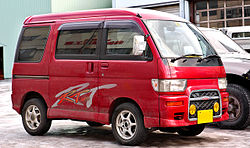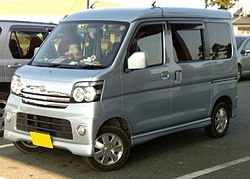Daihatsu Atrai
| Daihatsu Atrai | |
|---|---|
| Production period: | since 1981 |
| Class : | Minivan |
| Body versions : | Station wagon |
The Daihatsu Atrai is a four-seater minivan that has been in production since 1981. The model is technically related to the Daihatsu Hijet . Originally it was the better equipped minibus variant of the Hijet, but was developed into an independent model. The origin of the name lies in the French charming, which means attrai translated into Japanese. In Europe, too, the Atrai was offered parallel to the Hijet, but it was named after it. After the Subaru Sambar had also appeared as a 7-seater in Japan , it was decided to compete with the Daihatsu Atrai 7 (also known as Toyota Sparky ), which appeared on the home market in 2000.
1st generation S65V / S66V (1981–1986)
| Hijet Atrai / Atrai I | |
|---|---|
|
Image does not exist |
|
| Production period: | 1981-1986 |
| Body versions : | Station wagon |
| Engines: |
Otto engines : 0.55 liters |
| Length: | 3195 mm |
| Width: | 1395 mm |
| Height: | 1865-1910 mm |
| Wheelbase : | 1815-1820 mm |
| Empty weight : | 675-810 kg |
In 1981 the Atrai first appeared on the market as Hijet Atrai. This was the Daihatsu Hijet S65 / S66 in a minibus version with four seats. In addition to the flat roof, a high roof was also available. Unlike the minibus version of the Hijet, the Atrai had carpeting throughout the vehicle and the seats were covered with fabric. The dashboard and interior panels were gray. The seats could be folded into a lounger or were collapsible. A central sunroof with manually operated sun blind was standard, depending on the version. The 550cm³ type AB20 with a 4-speed manual gearbox was used as the motor, the power of which was transferred to the front wheels. As with the Hijet, the engine was located between the axles .
- In 1982, switchable all-wheel drive was also available, with the tire size being 12 inches.
- In 1983 the name Hijet was dropped and the car was only called Atrai. The AB55 engine was now also offered, an AB20 with turbocharger , coupled with a 5-speed manual transmission. The front grill was now white and silver on the turbo to distinguish it from the Hijet. Disc brakes and air conditioning were now available as options. The Atrai 4WD received manually operated freewheel hubs to improve fuel efficiency.
- From 1985 there was also a 3-speed automatic transmission on request .
2nd generation S80V / S81V / S82V / S83V (1986–1994)
| Atrai II | |
|---|---|
|
Atrai II |
|
| Production period: | 1986-1994 |
| Body versions : | Station wagon |
| Engines: |
Petrol engines : 0.55-0.66 liters |
| Length: | 3195-3295 mm |
| Width: | 1395 mm |
| Height: | 1900 mm |
| Wheelbase : | 1800 mm |
| Empty weight : | 700-950 kg |
In 1986 a new model of the Atrai came on the market. The Atrai now basically had a high roof. The EB two-cylinder engine from the Daihatsu Mira was now the standard engine. It was also available again with a turbocharger, in this version again with a 5-speed instead of 4-speed manual transmission. A 3-stage automatic was also offered again. The radiator moved under the bumper seat to create more leg room. The 4WD model now had automatic freewheel hubs. The rear window was now installed higher than its predecessor, plus smaller windows in the passenger compartment to convey more comfort. In addition to the central glass roof, which now has an electric sun blind, a tilting glass roof was now also available over the driver and front passenger seats.
- From 1987 there was also the all-time 4WD called permanent all-wheel drive with a center differential.
- In 1988 the headlights were changed and the 4-speed gearbox was discontinued. The interior was no longer gray, but two-tone brown and blue.
- In 1989 the front bumper was redesigned and a new steering wheel was introduced, the body was available with two-tone paintwork.
- In 1990 the EB standard engine was discontinued and was replaced by the EF-ES three-cylinder engine with 660cm³, as EF-GS with automatic transmission and EF-XS / TS (automatic) with turbocharger.
- In 1991 the Atrai Cruise appeared with color-contrasting bumpers and special wheels at a lower entry price, which from then on accounted for the main share of sales. The central sunroof was now an electrically operated glass roof with an electrically driven film as sun protection.
3rd generation S120V / S130V (1994–1998)
| Atrai III | |
|---|---|
|
Atrai III |
|
| Production period: | 1994-1998 |
| Body versions : | Station wagon |
| Engines: |
Gasoline engines : 0.66 liters |
| Length: | 3295 mm |
| Width: | 1395 mm |
| Height: | 1855 mm |
| Wheelbase : | 1900 mm |
| Empty weight : | 840-990 kg |
In 1994 the revised model started, which remained true to the appearance of the predecessor, but was revised in the inner values. While the model corresponded in length to the largest model of its predecessor, it was minimal in height and significantly smaller in the wheelbase. For the first time there was also an anti-lock braking system for the SR sport versions and the 4WD. The rear seats were now individually movable. As a Riberno, the Atrai was more simply equipped and offered without a sliding door on the driver's side.
- In 1996 there was also a 660cc twin-cam engine for the first time
- 1997 In January air conditioning became standard in most models and a retractable rear spoiler was offered. In October there was Keyless Go and for the first time a complete leather interior on request ex works. The retro series with a nostalgic front was also new.
Fourth generation S220V / S230V / S220G / S230G (1999-2005)
| Atrai IV | |
|---|---|
|
Atrai IV |
|
| Production period: | 1999-2005 |
| Body versions : | Station wagon |
| Engines: |
Gasoline engines : 0.66 liters |
| Length: | 3395 mm |
| Width: | 1475 mm |
| Height: | 1865 mm |
| Wheelbase : | 2420 mm |
| Empty weight : | 940-1000 kg |
In January 1999 a completely new model appeared. It was developed by an Italian design office. Here, too, the engine was installed as a mid-engine under the front seats. For the first time there was also a roof rail. ABS was now standard on all models, as was a brake assistant . The Atrai achieved the shortest braking distances in its class. The C w value was 0.36. The engines corresponded to those of the predecessor. The demand for the model was very high and customers had to wait at least 3 months.
- In 2000 there were some small improvements. The CL turbo version was new as an inexpensive variant. In addition, the larger Daihatsu Atrai 7 started . The S-Edition special models with an extended infotainment system started in September 2000.
- In 2001, the previous higher-quality CL Turbo Clade became the Turbo Touring. This had aluminum wheels and a rear spoiler as standard.
- From 2002 there was an optional 4-speed automatic transmission for the turbo engine.
- In 2004 there was another special edition called G Selection. The 5-speed manual transmission dropped out of the program after the engines were redesigned in favor of lower emissions and fuel consumption.
5th generation (2005 -) S320G / S330G / S321G / S331G
| Atrai V | |
|---|---|
|
Atrai V |
|
| Production period: | since 2005 |
| Body versions : | Station wagon |
| Engines: |
Gasoline engines : 0.66 liters |
| Length: | 3395 mm |
| Width: | 1475 mm |
| Height: | 1875 mm |
| Wheelbase : | 2450 mm |
| Empty weight : | 970-1090 kg |
In 2005 the revised Atrai was introduced. A new HDD-Navi-Edition series, with 7-inch monitor navigation and hard drive radio. The only transmission was a 4-speed automatic.
- In April 2006, the Black Edition was introduced with black leather seats, a black instrument panel, a left electric sliding door and other comfort features.
- In 2007, the muffler moved under the bumper and the Black Edition added white inclusions.
- Since September 2009 the Atrai has also been offered by Fuji Heavy Industries as Subaru Dias Wagon .
- In September 2010, there were small improvements, whereby the emission of exhaust gases was essentially reduced by a revision of the engine control.
- Larger rear headrests have been available since April 2012.








